Welcome to FISH FOOD TIMES
Apr. 2025 issue No.256

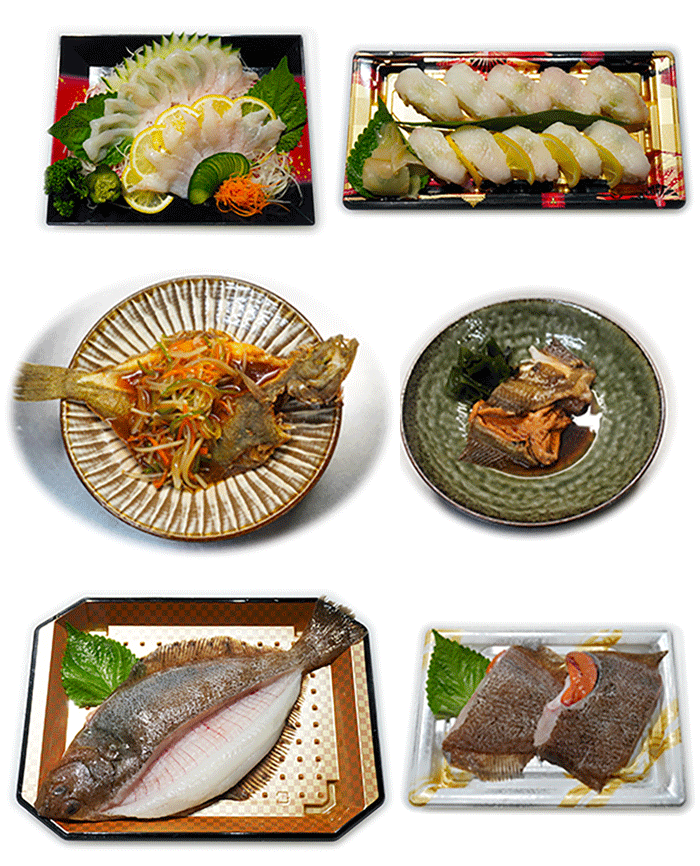
Roundnose flounder
What is roundnose flounder・・・
I bought three roundnose flounders weighing 367g to 412g. At my usual store, the person in charge charged me 400 yen per fish, so I think the price per kg should be around 1,000 yen.
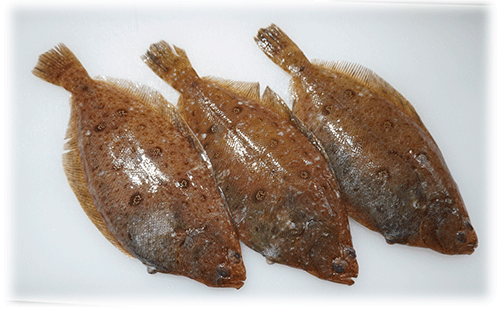
The fish's Japanese name, mizukarei, seems to have come from the characteristic watery nature of its flesh, so it is usually not made into sashimi or sushi, and it is generally a fish that is not highly rated in terms of price.
All of the roundnose flounders I purchased this time had a round, raised upper part of their body, and their ovaries had grown to the point that they were clearly visible from the outside, making it clear that they were in the middle of their season.
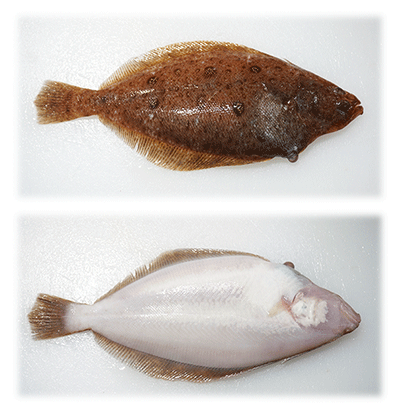
When I turned the roundnose flounder over and looked at the underside, it still had its pure white color, and both sides of its surface were covered with a generous amount of slime.The gills also had a nice red color, so I judged it to be extremely fresh.
I suddenly wondered, ”What kind of sashimi and sushi at Roundnose Flounder would taste like?'' So, I asked the person at the fish counter where the roundnose flounders were lined up, "Do you think roundnose flounder sashimi is delicious?" Then, he replied with a laugh, "I won't take any responsibility even if your stomach was broken...''
It's understandable that this would happen. Such a reaction is, so to speak, to be expected, as even I myself might have given a similar response if someone asked me this question.
For those in the fishing industry who live in Fukuoka and other areas of northern Kyushu who have been involved in the fishing industry for a long time, the traditional image of roundnose flounder has been synonymous with ”Western bottom trawl fishery.'' Therefore, the idea of making Western bottom trawl fishery into sashimi is basically not connected to it.
Back in the 1970s, when I used to go to Nagahama Fish Market in Fukuoka every morning, Western bottom trawl fisheries were still a thriving fishing industry. I often saw the Western bottom trawl fishery boats docked at the quay of the fish market unloading their catches, not at the first auction at 3am, but a little later, at 6 or 7am. The fish that were unloaded were a truly various types, including not only roundnose flounder, but also blackthroat seaperch, which we featured in last month's issue, as well as yellowback sea-bream, anglerfish, and many other kinds of fish.
At that time, the idea of quantity over quality still prevailed, and wooden toro boxes were filled with fish that clearly exceeded the standard of about 15 kg. I remember the toro boxes being stacked like a mountain (not two or three layers, a literal mountain) and the receiving auctioneer climbing to the top of the pile, looking down at the large number of local brokers and shipping brokers gathered below, and loudly shouting industry slang like "Wasagen! Gengen! Gatabo!" as he conducted the bidding. By the way, the industry slang for the numbers 1 to 10 used within the fish industry related to the Fukuoka Fish Market is soku ryan ten wasa genko gata yoshi tame kiwa pai, with wasa gen meaning 450 yen or 4,500 yen.
In other words, Western bottom trawl fisheries fishs were not treated with the same care and care as they are in today's era, and most of them were comparatively cheap fish called ”deli fish,'' which were sold in boxes of 15 kg or more in toro boxes, and even when purchased by retailers, they were traded in boxes rather than individually. Therefore, in terms of uses, only a minority of fish are suitable for sashimi; the majority are suited to being grilled with salt or boiled, and the roundnose flounder has historically been classified as one of those fish.
However, please remember that even blackthroat seaperch, which is now known as a super high-quality fish, was treated the same as roundnose flounder at the time, and even I had no idea at the time that blackthroat seaperch could be eaten as sashimi. The blackthroat seaperch from Western bottom trawl fisheries fishes not only has lost its red color and turned whitish, but also has almost no scales and the body is soft and not firm, so according to general standards for judging freshness, it is not appropriate to prepare it as sashimi.
Similarly, if you consider the roundnose flounder, which has a whitish body, soft, non-firm flesh, and the fact that it is not uncommon for its internal organs to protrude from its anus, you probably wouldn't normally try to eat it raw. For those who have been involved in the fishery industry for many years, the image of the roundnose flounder is not something that can be easily erased, and it must be deeply etched in their mind as the image of the fish. So when I said I wanted to try eating roundnose flounder sashimi, I was warned with a laugh, "I'm not responsible if you get an upset stomach..."
Commercialization of roundnose flounder as raw food
I was informed that the roundnose flounder I purchased this time was produced in Nagasaki Prefecture, but it is unclear how it was caught, so I can only speculate. Judging from the careful way it was handled and how fresh it looked, I thought it was probably caught in a small bottom trawl in the nearby waters.
Of the three roundnose flounders, I decided to deep fry one and stew the other. I decided to cook two of them normally, but I decided to make sashimi and sushi out of the remaining roundnose flounder, which had the smallest ovaries and seemed the freshest. Since I was the one eating it and not selling it, I only had to prepare myself for an upset stomach. Anyway, for the first time in my life, I decided to try eating roundnose flounder as sashimi and sushi.
First, the roundnose flounder is disassembled into three pieces for sashimi and sushi, and then the skin is removed.
| Disassembling process of three pieces of roundnose flounder for sashimi and sushi | |
|---|---|
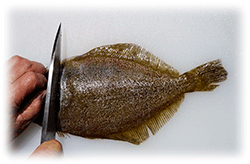 |
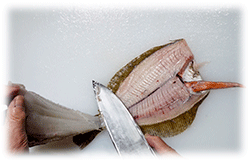 |
| 1,Place the roundnose flounder with its abdomen facing away from you and its head to the left, and point the tip of the deba knife towards the upper right. | 8,Cut off the side with eyes near the tail fin. |
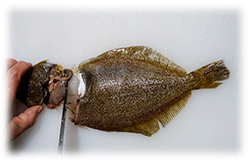 |
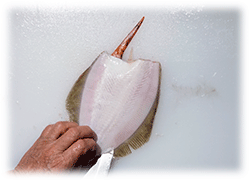 |
| 2,Using a deba knife, cut at an angle that does not damage the valuable ovaries, cut off the head, and remove the internal organs. | 9,Make an incision near the dorsal fin of the side without eyes using reverse-handed knife. |
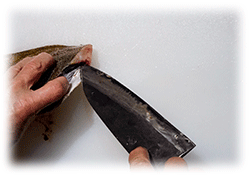 |
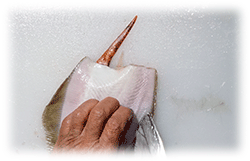 |
| 3,Make an incision in the film of the lump of blood inside the abdominal cavity with the tip of a knife and wash away the lump of blood. | 10,Using the reverse-handed knife, cut along the dorsal fin towards the head. |
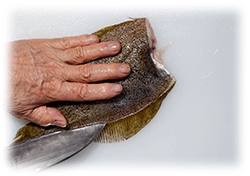 |
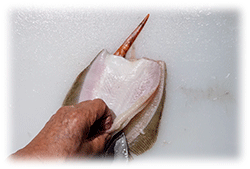 |
| 4,Make a shallow incision near the pelvic fin on the side of the eyes. | 11,Start cutting from the side without eyes near the pelvic fin and work your way towards the backbone. |
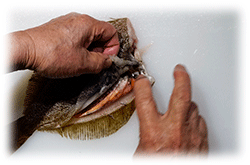 |
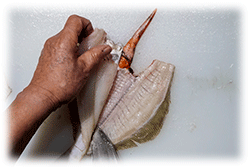 |
| 5,Use your fingers to separate the valuable ovaries from the body of the fish. | 12,Go beyond the backbone, cut toward the abdomen, and separate the side without eyes. |
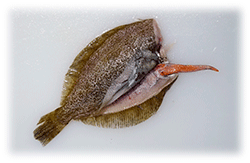 |
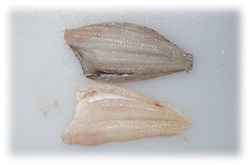 |
| 6,Use your fingers to push the ovaries toward the head, being careful not to damage them with the knife. | 13,The side with eyes of the three pieces disassembled roundnose flounder is at the top, and the bottom is side without eyes. |
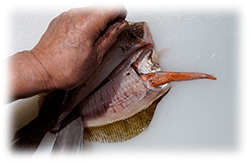 |
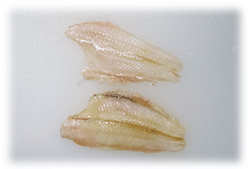 |
| 7,After removing the ovary, cut towards the backbone and finally cut open the dorsal fin side with eyes. | 14,The top is the skinned side without eyes, and the bottom is the side with eyes. |
The work of skinning the roundnose flounder was completed. I decided to separate this into two back bodies and two belly bodies, using only the back bodies for sashimi and the belly bodies for nigiri sushi.
| Roundnose flounder's sushi making process | |
|---|---|
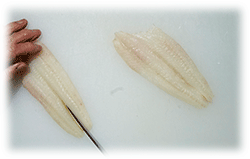 |
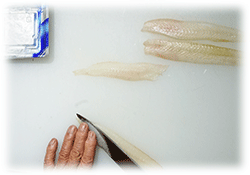 |
| 1,Divide the skinned roundnose flounder into two back bodies and two belly bodies. | 3,Cut the belly body on the side with eyes into a sogitsukuri in the left position. |
.gif) |
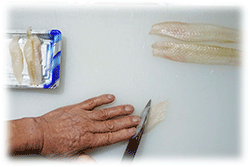 |
| 2,The state is divided into a back body and a belly body. | 4,Cut the belly body without eyes on the side into a sogitsukuri in a right posture. |
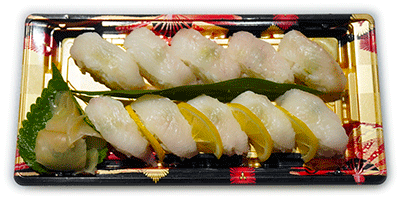 |
|
| 10 pieces of nigiri sushi made with roundnose flounder belly body | |
| roundnose flounder's sashimi work process | |
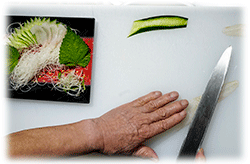 |
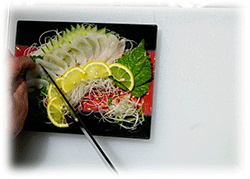 |
| 1,In a right posture, make the back body of the side with eyes sogitsukuri sashimi. | 3,If the sashimi moves unexpectedly and falls apart, adjust it with a yanagiba knife. |
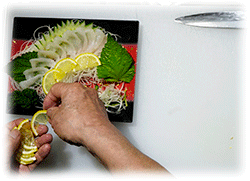 |
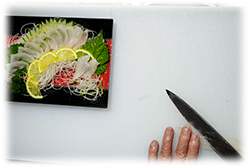 |
| 2,After cutting the back body of the side with eyes, arrange the back body of the side without eyes as sashimi. For this purpose, place a lemon slice on the front side. | 4,In a left posture, make the back body of the side without eyes sogitsukuri sashimi. |
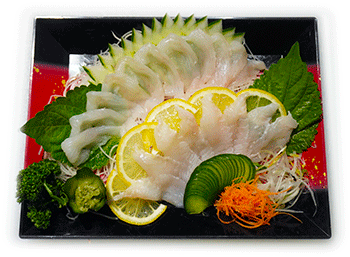 |
|
| Usutsukuri sashimi made from the back meat of roundnose flounder | |
In this way, roundnose flounder's nigiri sushi and usutsukuri sashimi were completed. The cost of one pack of products can be estimated at 200 yen each, if only the fish ingredients are counted. In addition to this, for nigiri sushi there are the costs of rice, container, and other ingredients, and for sashimi there are the costs of radish ken, ashirai, and the container. It seems that there are some differences in cost calculations depending on the company, but it is safe to assume that the selling price will be between 500 and 1,000 yen, so the markup ratio should be in the category of a welcome honor.
It seems that these products can be placed in the superior category in terms of profits, but what does the roundnose flounder taste like?I think this is what readers are most curious about.
First, let's write the conclusion. It is ”delicious.'' The texture is definitely soft, and if you ask me if it's watery, I might say it's watery. However, fish that are relatively high in water content include red tilefish, as well as threadfin bream, yellowback seabream, and barracuda, all of which also have watery flesh. So, does that mean that these fish taste bad? On the contrary, they are delicious. In other words, the moistness of the roundnose flounder actually has a greater effect of enhancing its flavor.
And best of all, I didn't get an upset stomach after eating it. The freshness of roundnose flounder is now mainly determined by small-scale bottom trawl fishing in nearby waters, and it seems that methods for handling fish and managing freshness have clearly evolved since the days of Western bottom trawl fishery. Therefore, it may be better not to have strange, prejudiced assumptions, such as that today's roundnose flounders should not be eaten raw, such as as sashimi.
These days, farmed fish that are unnaturally bloated and greasy are becoming popular. However, there are fish like roundnose flounder that have a softness that is different from Pre-rigor fish, have a low fat content, have a light taste, and are a bit watery, but are really delicious. These fishes should also be enjoyed as one of the many wild fishes available.
Roundnose flounder fillets for simmering and boiled fish
This is how I proved with my own taste that eating raw roundnose flounder is delicious, but since roundnose flounder is currently in season with roe, you can't miss the standard dishes of boiled fish and fried fish. Assuming that roundnose flounder will be sold at a fish store, I will first show an example of commercializing fillets for boiled fish, and then describe the process of making boiled fish.
| Roundnose flounder fillet work process | |
|---|---|
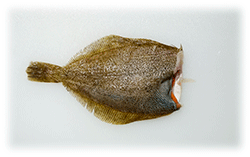 |
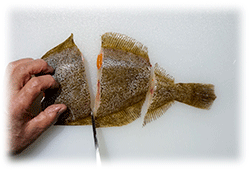 |
| 1,A roundnose flounder with its head removed, the blood washed away, and the water wiped off. | 3,The fish body, which has become almost square after separating the tail, is cut into fillets of similar size. |
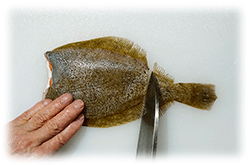 |
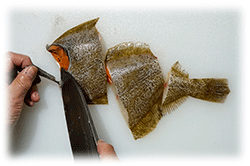 |
| 2,Turn the head side to the left, cut off the tail side to separate it into two parts, and adjust the shape of the remaining parts. | 4,Partially separate the skin to highlight the ovary, which is the most valuable part of the roundnose flounder. |
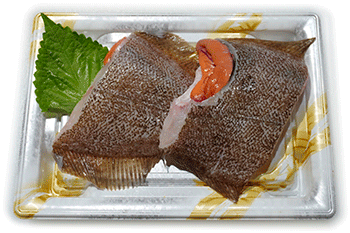 |
|
| Fillet of roundnose flounder with red ovaries highlighted | |
The roundnose flounder I purchased this time has large ovaries and is in season, so I should make sure to emphasize this to my customers. To achieve this, even though it may be a little troublesome, I would like you to express the value of the fish by cutting a little of the skin covering the ovaries and showing that they are carrying large fish eggs.
Next is a boiled fish dish made with fillets of the roundnose flounder. Boiled flatfish with roe is considered to be one of the most standard fish dishes, so although the following process may not be necessary, I decided to include it as a standard dish.
| Boiled fish work process of roundnose flounder |
|---|
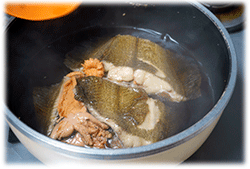 |
| 1,Add the roundnose flounder fillets to the boiling broth and pour the broth over the surfaces of the fillets with a ladle, ensuring that the flavor is evenly absorbed. |
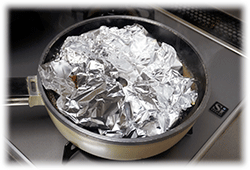 |
| 2,A homemade aluminum foil lid is placed over the pot to prevent the broth from evaporating while simmering. |
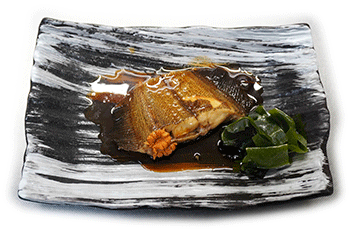 |
| The broth remaining in the pot is further reduced and then poured over the fillets to give them a glossy finish. |
 |
| Garnish with boiled, fresh, seasonal wakame seaweed for a seasonal garnish. |
One side open figure fried fish to increase the value of roundnose flounder
After the classic boiled fish, there is fried fish. It is not so easy to add value to a common fish that is intended for deep-frying and sell it at a higher price. However, there is actually a value-adding technique that can be used not only for roundnose flounders, but for most flatfish. It is the following product for ”One side open deep frying.''
| roundnose flounder's One side open figure fish product work process | |
|---|---|
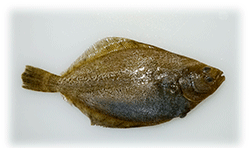 |
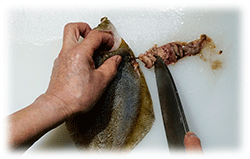 |
| 1,Although it was the smallest of the three fish, it still weighed 367g, which was too large for frying a single figure. | 5,Make a small incision on the side of the abdomen and use the tip of the knife to scrape out the internal organs. |
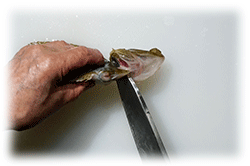 |
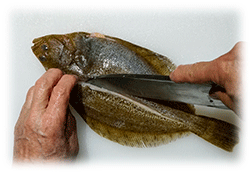 |
| 2,After removing scales, cut gill membranes. | 6,After rinsing the inside of the abdominal cavity and wiping it dry, make a vertical incision along the backbone on the side with eyes. |
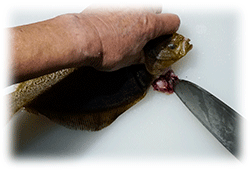 |
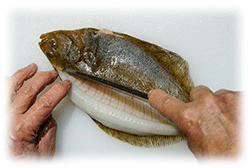 |
| 3,Hold down the gills with the back of the knife and separate them from the body of the fish. | 7,From the vertical cut, cut towards the dorsal fin, over the central bone, and stop cutting just before the engawa. |
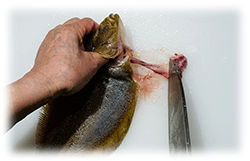 |
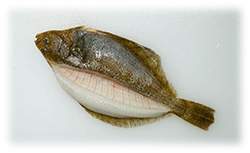 |
| 4,Move the fish to the left and separate the gills. | 8,The back body of the side with eyes has been cut open. |
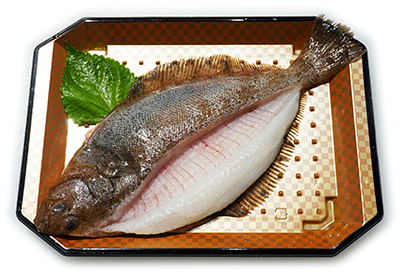 |
|
| Roundnose Flounder's One Side Open Figure Fish product, presented in a way that emphasizes the open, transparent flesh of the fish. | |
How do readers feel when they see this one-sided open figure roundnose flounder? In my opinion, this method makes the part of the fish meat transparent, and it definitely looks fresher than if only the dark surface of the roundnose flounder skin was visible. It is nearly impossible to do this with frozen flounder, and even if the same shape could be created with frozen flounder, it would likely look bad due to discoloration and dripping, making it unsellable.
If you turn this one-sided roundnose flounder into a figure fried fish, it will look like the following.
| Roundnose flounder thick starchy sauce figure fried fish | |
|---|---|
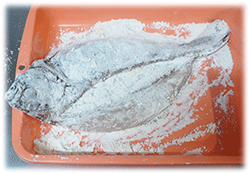 |
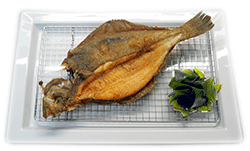 |
| 1,Pour 1 tablespoon of sake over the roundnose flounder, let it sit for a while, remove excess water, season with salt and pepper, and coat with flour. | 4,The color changes to a suitable degree and the figure fried fish is completed. |
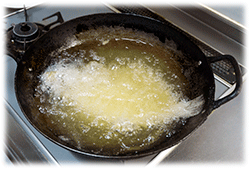 |
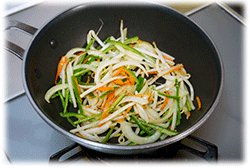 |
| 2,Place in oil at 180℃ and fry. | 5,In a separate pan, add the carrots, bell peppers, julienned onions, and bean sprouts and stir fry. |
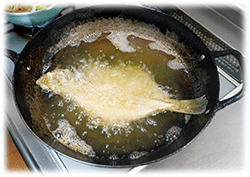 |
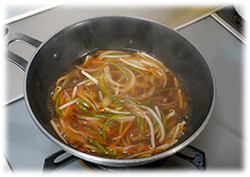 |
| 3,After about 8 minutes, the roundnose flounder will be cooked and rise from the bottom to the top, and it will be done. | 6,Add a sweet and sour sauce made from vinegar, soy sauce, and sugar to the stir-fried vegetables, and once it boils, mix in water-dissolved potato starch to finish the sweet and sour sauce. |
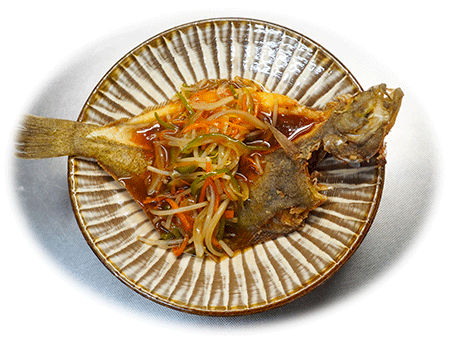 |
|
| Pour the finished sweet and sour sauce over the roundnose flounder figure fried fish and it's done. | |
The resulting ``Roundnose flounder thick starchy sauce figure fried fish'' was extremely delicious even when it was cold. This dish is covered in a sweet and sour sauce, so in the end the distinctive shape of the open mouth ends up being hidden, but when you actually eat it, this shape makes it easy to insert chopsticks into and eat. Well, I felt that the sweet and sour bean paste taste was a little too intrusive, but overall I felt that the dish was well balanced and delicious.
A fish called flatfish
Well, this month's issue has written about roundnose flounder, but I think it's time to conclude. The roundnose flounder is a common fish that is typically classified as a deli fish, but in addition to the roundnose flounder, there are apparently more than 30 species of fish called flatfish in Japan and nearly 100 species worldwide. However, I must confess that I don't actually have enough knowledge about other flatfish to talk about them in detail. This is because there are so many different types of flatfish, and even when I try to dig up the knowledge I have about them, I sometimes get confused and unable to tell the difference between two very similar looking flatfish.
Unlike flounders, most species of flatfish are not farmed. The reason is that flatfish are very long-lived fish, and because of their long lifespan they grow very slowly. For this reason, when flatfish are farmed, they have to be fed with food for a long time before they reach a shipping size, making the farming process inefficient and making them not very suitable for farming.
However, there are exceptions. The barfin flounder, a species with high market value, is already being farmed in Hokkaido and Aomori. The Barfin Flounder, a female of which can grow to 80cm in length and weigh 6kg, mainly inhabits the northern coastal areas of Japan. It was given this name because it has black stripes on its dorsal and anal fins, and its scales are large and rough, resembling the bark of a pine tree. Landings of this fish have also been declining, and Hokkaido is working to release seedlings in the waters west of Erimo in line with a plan to restore the barfin flounder resource.
The image below is a branded fish called Ouchou, a farmed barfin flounder from Tomakomai, that was posted on the Hokkaido Fisheries Federation's website.
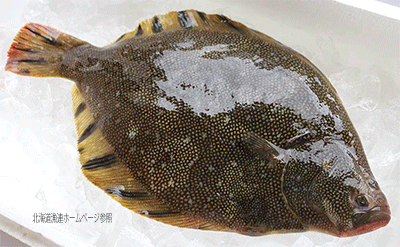
On the Hokkaido Fisheries Association's website, a single fish weighing about 700g is being sold for around 5,000 yen, a price that truly puts it in the category of an extremely luxurious fish.
This month's theme is not the barfin flounder, but the roundnose flounder. How do you feel when comparing these two flatfish? The purchase price for a roundnose flounder weighing about 400g was 400 yen per fish, so I think it is immediately obvious how excellent the cost performance is. I think it is not uncommon for restaurants and high-end sushi restaurants to purchase Barfin flounder, but paying 5,000 yen for a 700g fish at a seafood retail store is not something that can be easily done.
So, I will write down what I want to say at the end. Even if a fish like the roundnose flounder is labeled as a deli fish and sold cheaply, if you can assess with your own eyes how it was handled from the time it was caught until it was sold at the wholesale stage, and how carefully it was handled from the time it was purchased by the retailer until it was sold, you can enjoy an unexpected "exquisite flavor."
I think this is the case with anything, but we want to avoid having stereotypical prejudices about things.
An opinion and the communication are to iinfo@fish food times
Date of updating 1 Apr. 2025
